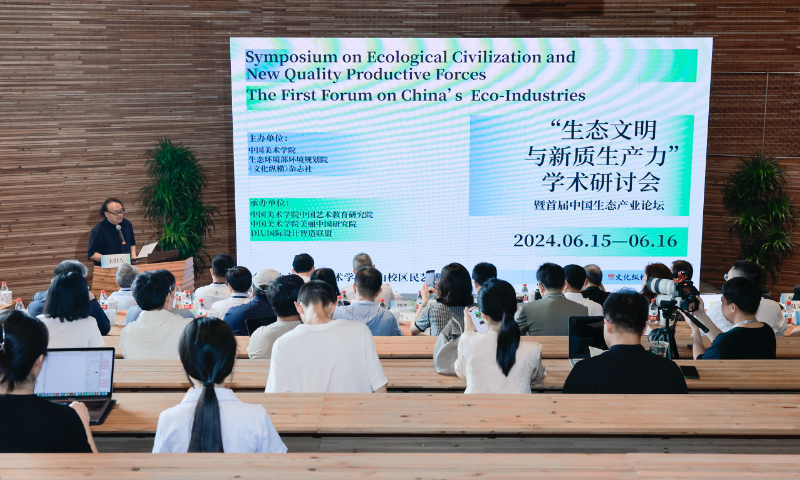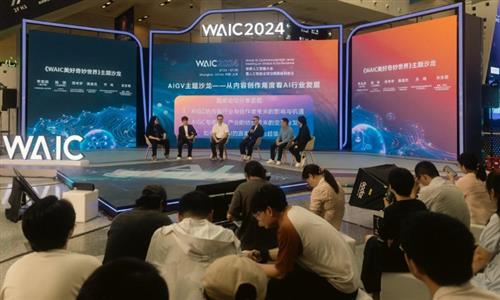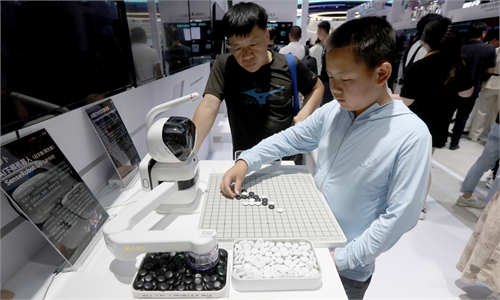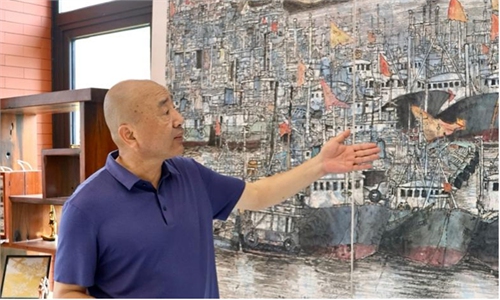IN-DEPTH / IN-DEPTH
Exclusive: Integration of art and new tech drives societal progress, environmental sustainability, says China's top art school chief

Professor Gao Shiming, president of the China Academy of Art, speaks at the Symposium on Ecological Civilization and New Quality Productive Forces on June 15, 2024 in Hangzhou, East China's Zhejiang Province. Photo: Shan Jie/GT
Editor's Note:
In contemporary times, the concept of new quality productive forces has become deeply ingrained in people's minds. It not only represents industrial innovation but also serves as a crucial driving force for social cultural development and environmental sustainability.
Art, as an essential component of culture, when combined with new quality productive forces, exhibits unprecedented vitality and creativity.
In a recent interview with the Global Times, Professor Gao Shiming, president of the China Academy of Art based in Hangzhou, East China's Zhejiang Province, discussed this trend and the academy's practices.
Gao mentioned that with the rapid development of technology, especially the widespread application of artificial intelligence (AI), the fusion of art and technology is opening up a new realm of creation, providing infinite possibilities for artistic expression. Ultimately, this will feed back into society and national education, enhancing public aesthetic literacy and cultivating innovative talents to meet the demands of the new era.
Cater to time
Today, artists in China, led by the talents from the China Academy of Art, are embracing a novel approach to art through an environmental lens. This engagement in ecological civilization not only enhances the aesthetic of the environment but also fosters a societal consciousness towards sustainable development.
"Everyone has a responsibility when it comes to ecological issues and the construction of a 'better China,'" Gao emphasized.
Gao further emphasized the crucial role of art in this systemic project: "Art can genuinely participate in and contribute to various areas, such as rural revitalization and urban aesthetics, by enhancing community renewing."
He introduced the China Academy of Art's practices in ecological art: "In recent years, ecological art has become a global hotspot, but what we do is not narrowly defined ecological art. We engage in more practical, broader participation in the real restoration of ecosystems, the reconstruction of ecological systems, and the research, exploration, and expression of ecological civilization."
Zhejiang Province, where the academy is located, is a famous water town. It initiated a comprehensive campaign named Five Water Treatment to the improve water environment since the end of 2013.
In 2017, the academy launched the "Frontline of Five Water Treatment" field activity, a landmark project that brought over 1,500 teachers and students to Zhejiang's rivers and water systems. During the month-long activity, students delved into the core areas of water environment management, not only observing and learning but also actively participating in the water treatment work, creating over a thousand artworks reflecting the people and events involved in water management.
These students treated the on-site investigation as a "field classroom," immersing themselves in the process, proactively exploring and experiencing it. Through deep involvement, students not only realized the importance of harmonious coexistence between humans and nature but also comprehended the profound meaning of ecological civilization in practice.
Gao believes that new quality productive forces have three core characteristics: High "ecologization," high intelligence, and high innovation. He emphasized that these characteristics collectively constitute the key driving force for the development of the new era.
He mentioned, "I find that art and design can facilitate the application of technology," which contrasts with the common belief that only scientific and technological achievements can be practically applied.
According to Gao, if technology or patents are not transformed into actual products or suitable application scenarios, they cannot realize their value. Art and design, especially industrial design, serve as the bridge connecting innovation and application.
"Our design is not just about product design or its appearance. It involves the production process and application scenarios of the product," he said. This means that design encompasses not only the appearance and function of the product but also the entire production process, application scenarios, and the design of the entire system network.
To adapt to this trend, in June 2021, the China Academy of Art established the Research Institute of Better China Initiative, which focuses on three aspects: Creating an art think tank for urban and rural development, constructing a highland for public aesthetic cultivation, and promoting social innovation.
Gao told Global Times that Chinese people excel in innovation from 0 to 1, with art and design being a crucial part of this process. The ecological industry represents a new driving force based on ecological principles, encompassing tourism, wellness, cultural and artistic industries, agritourism, and smart agriculture.
"The development of ecological industries not only generates new momentum but also serves as a catalyst for the self-iteration of new industries, providing fresh energy and internal drive," he noted.
"And art can play a significant role in rural revitalization, urban aesthetics, community building, as well as in cultural tourism, creative industries, education, and entertainment," he explained.
To be or not to be
Today, creations like AI novels, AI music, AI paintings, AI movies, and AI short videos are rapidly emerging, akin to Aladdin's lamp granting wishes. Artificial intelligence democratizes art creation, simplifying the once complex processes into text prompts and machine-generated outputs, transforming words into images and videos with ease.
How to respond to this trend - resist or embrace it - places artists at a crossroads.
Gao views AI as an integral part of the highly intelligent aspect of new quality productive forces, showcasing its unique potential in artistic creation. Therefore, he maintains an open attitude toward the integration of AI and art.
"Artificial intelligence will become your gravedigger if you avoid or resist it," Gao said. "AI is not just a tool for humanity; it is also a mirror."
AI algorithms can analyze vast amounts of artistic works, helping creators explore new forms and methods of expression and even independently generate works with artistic value.
The China Academy of Art's exploration in AI is particularly noteworthy. Recognizing the unstoppable trend of AI, the school established an AI club that attracted numerous students. They not only explored basic applications but also conducted in-depth research on AI generation and application scenarios.
In April this year, the school also established an AI center aimed at breaking down barriers between technology, art, design, and industry, creating a cross-disciplinary, open knowledge laboratory to promote the deep integration of digital intelligent technology and art.
The China Academy of Art is also deeply involved in the planning and preparation of the World Artificial Intelligence Conference, becoming the only art college participating in this event.
Gao believes that the more advanced AI becomes, the more human beings need artistic intelligence; the more developed digital virtual technology becomes, the more precious sensory experiences and sensibilities derived from art become.
The future task of art is to maintain human sensory vitality and spiritual autonomy in an increasingly intelligent, automated, and virtual society, ensuring people's well-being in a multi-media, mixed-reality environment, he said.
Role of education
Amid the wave of educational reform, the integration of art education and technology is becoming a significant force driving social progress.
"Our art education is not just about self-cultivation; more importantly, it is about being a proactive discipline rooted in China," Gao said, noting that combining art with environmental protection can cultivate talents with innovative thinking and practical skills and inspire society's focus on and participation in ecological civilization construction.
Addressing the transformative role of design and art in the development of new quality productive forces, Gao emphasized, "As we participate in the occurrence and development of new quality productive forces, the significance of design and art itself changes, and its scenarios undergo a tremendous transformation." Design and art, therefore, are not only creative activities but also drive changes in teaching content, discipline development, and professional construction.
He highlighted the impact of this transformation on education: "The change in application scenarios will in turn promote our own teaching changes, the self-iteration of new disciplines, the self-construction of professions, and educational reforms will naturally emerge."
"We need to turn art into something that can participate in the social process, integrate into daily life, reconstruct our living and production, and of course, contribute to ecological construction," he said.



